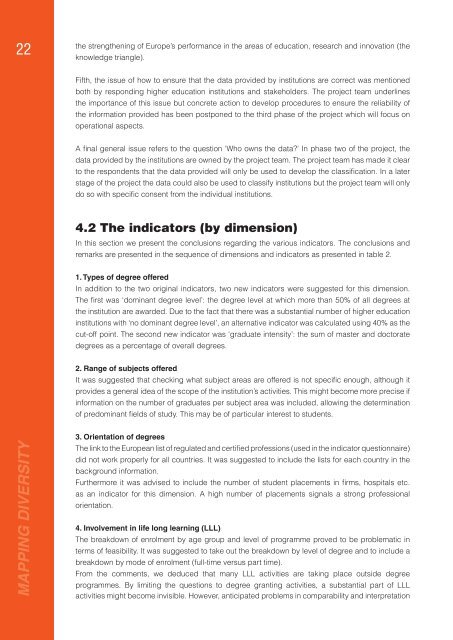Mapping Diversity: Developing a European Classification of ... - U-Map
Mapping Diversity: Developing a European Classification of ... - U-Map
Mapping Diversity: Developing a European Classification of ... - U-Map
You also want an ePaper? Increase the reach of your titles
YUMPU automatically turns print PDFs into web optimized ePapers that Google loves.
22<br />
the strengthening <strong>of</strong> Europe’s performance in the areas <strong>of</strong> education, research and innovation (the<br />
knowledge triangle).<br />
Fifth, the issue <strong>of</strong> how to ensure that the data provided by institutions are correct was mentioned<br />
both by responding higher education institutions and stakeholders. The project team underlines<br />
the importance <strong>of</strong> this issue but concrete action to develop procedures to ensure the reliability <strong>of</strong><br />
the information provided has been postponed to the third phase <strong>of</strong> the project which will focus on<br />
operational aspects.<br />
A fi nal general issue refers to the question ‘Who owns the data?’ In phase two <strong>of</strong> the project, the<br />
data provided by the institutions are owned by the project team. The project team has made it clear<br />
to the respondents that the data provided will only be used to develop the classifi cation. In a later<br />
stage <strong>of</strong> the project the data could also be used to classify institutions but the project team will only<br />
do so with specifi c consent from the individual institutions.<br />
4.2 The indicators (by dimension)<br />
In this section we present the conclusions regarding the various indicators. The conclusions and<br />
remarks are presented in the sequence <strong>of</strong> dimensions and indicators as presented in table 2.<br />
1. Types <strong>of</strong> degree <strong>of</strong>fered<br />
In addition to the two original indicators, two new indicators were suggested for this dimension.<br />
The fi rst was ‘dominant degree level’: the degree level at which more than 50% <strong>of</strong> all degrees at<br />
the institution are awarded. Due to the fact that there was a substantial number <strong>of</strong> higher education<br />
institutions with ‘no dominant degree level’, an alternative indicator was calculated using 40% as the<br />
cut-<strong>of</strong>f point. The second new indicator was ‘graduate intensity’: the sum <strong>of</strong> master and doctorate<br />
degrees as a percentage <strong>of</strong> overall degrees.<br />
2. Range <strong>of</strong> subjects <strong>of</strong>fered<br />
It was suggested that checking what subject areas are <strong>of</strong>fered is not specifi c enough, although it<br />
provides a general idea <strong>of</strong> the scope <strong>of</strong> the institution’s activities. This might become more precise if<br />
information on the number <strong>of</strong> graduates per subject area was included, allowing the determination<br />
<strong>of</strong> predominant fi elds <strong>of</strong> study. This may be <strong>of</strong> particular interest to students.<br />
MAPPING DIVERSITY<br />
3. Orientation <strong>of</strong> degrees<br />
The link to the <strong>European</strong> list <strong>of</strong> regulated and certifi ed pr<strong>of</strong>essions (used in the indicator questionnaire)<br />
did not work properly for all countries. It was suggested to include the lists for each country in the<br />
background information.<br />
Furthermore it was advised to include the number <strong>of</strong> student placements in fi rms, hospitals etc.<br />
as an indicator for this dimension. A high number <strong>of</strong> placements signals a strong pr<strong>of</strong>essional<br />
orientation.<br />
4. Involvement in life long learning (LLL)<br />
The breakdown <strong>of</strong> enrolment by age group and level <strong>of</strong> programme proved to be problematic in<br />
terms <strong>of</strong> feasibility. It was suggested to take out the breakdown by level <strong>of</strong> degree and to include a<br />
breakdown by mode <strong>of</strong> enrolment (full-time versus part time).<br />
From the comments, we deduced that many LLL activities are taking place outside degree<br />
programmes. By limiting the questions to degree granting activities, a substantial part <strong>of</strong> LLL<br />
activities might become invisible. However, anticipated problems in comparability and interpretation

















